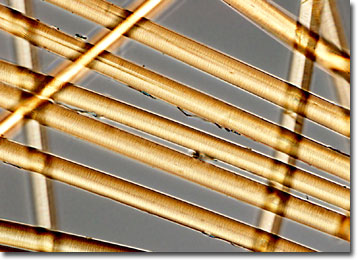Differential Interference Contrast Image Gallery
Kevlar Fibers
Five times stronger than steel, Kevlar is a synthetic fiber of the DuPont corporation that was first created in 1965 by scientists Stephanie Kwolek and Herbert Blades. Since that time, Kevlar has been utilized in a wide variety of applications and has helped save thousands of lives through its use in bulletproof vests.

Sometimes referred to as a Space Age material, it is the chemical structure and processing of Kevlar that makes it so strong. More specifically, Kevlar contains both aromatic and amide molecular groups. When molten Kevlar is spun into fibers at the processing plant, the polymers produced exhibit a crystalline arrangement, with the polymer chains oriented parallel to the fiber's axis. The amide groups are able to form hydrogen bonds between the polymer chains, holding the separate chains together like glue. Also, the aromatic components of Kevlar have a radial orientation, which provides an even higher degree of symmetry and strength to the internal structure of the fibers.
Strength is not, however, the only advantageous feature of Kevlar fiber. Kevlar is also lightweight, flexible, and resistant to chemicals and flames. Together these characteristics make Kevlar extremely useful to humans. Some of the common items that contain Kevlar include sports equipment, such as skis and tennis rackets, highly protective gloves, parachutes, and tires. Kevlar is also frequently used to construct lightweight ropes, which have been used for such crucial applications as mooring the large vessels of the United States Navy and securing the airbags in the landing apparatus of the Mars Pathfinder.
